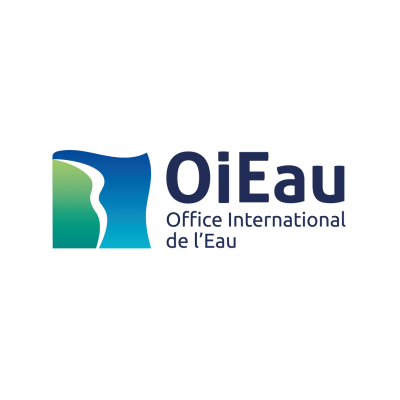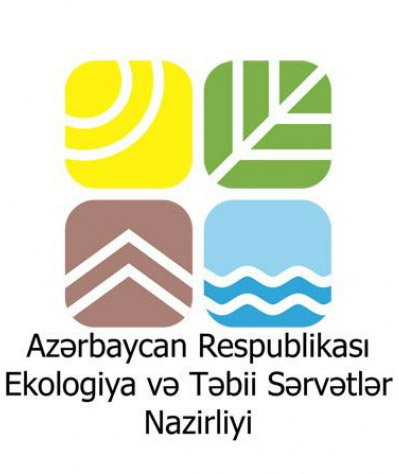| Ekoportal |
|---|
|
|
Taken fresh water
A brief summary
Azerbaijan is a water-scarce country with a long-term average annual water exploitation index (WEI) of more than 52.7% (WEI = 78% in 2019). Agriculture and irrigation are the sectors with the highest water demand and account for 90.3% of total annual water withdrawals.
Water withdrawals increased by 15% between 2000 and 2019, while renewable water resources decreased by 30.4% over the same period. More than 80% of water is taken from surface water resources. However, the proportion of water demand supplied by underground water resources has increased 4 times since 2000.
Is the extraction of fresh water resources sustainable in Azerbaijan?
Annual water exploitation index in the Republic of Azerbaijan (2000-2019)
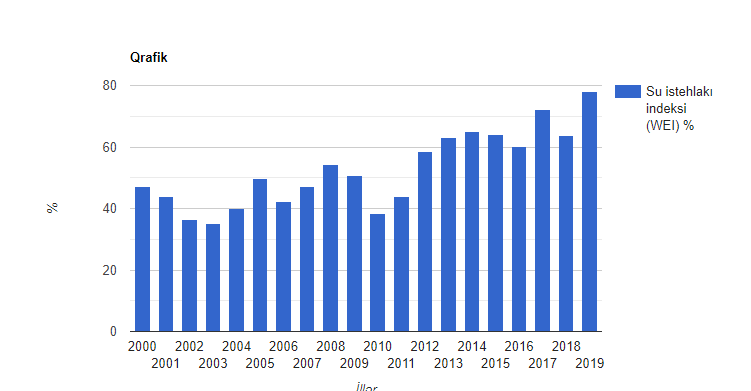
Annual renewable fresh water resources in Azerbaijan are approximately 22,747 m 3 (2000-2019) on average, which corresponds to an average annual figure of 2,570.7 m 3 per person .
However, due to the high demand for water in the agriculture and irrigation sectors, Azerbaijan withdraws an average of 45% of total recoverable fresh water resources each year. Such a pressure level exposes Azerbaijan to a serious water stress situation almost every year. Water use has gradually increased in recent years ( WEI = 78% in 2019 ) due to a significant decrease in renewable water resources (30.4% decrease from 2000 to 2019) and an increase in water withdrawals (15% over the same period ).
The WEI reflects the level of pressure on renewable water resources from water abstraction. Renewable water resources usually change under the influence of climate conditions. In particular, precipitation and actual evaporation affect them. During wet years (high precipitation and low actual evapotranspiration) , the WEI will be relatively low, while during dry years the WEI will be higher , even if water withdrawal remains the same .
According to the calculated WEI , Azerbaijan lives in water shortage conditions. On the other hand, it should be noted that seasonal and regional water scarcity conditions throughout the country vary significantly compared to the annual index.
Does water withdrawal decrease?
Water abstraction by sources in the Republic of Azerbaijan (2000-2019)

What are the pressures on freshwater resources by economic activities?
Although recoverable water resources fluctuate periodically, since 2012 annual recoverable water resources have remained below the long-term average, and withdrawal pressure on renewable water resources is increasing.
On average, 11,500 million m 3 of water is withdrawn annually in Azerbaijan to meet the water demand of various economic activities. Between 2000 and 2019, there has been an increasing trend in water withdrawal.
The total population of the country also increased by 24.2% between 2000 and 2019. This resulted in a decrease (44%) in available renewable water resources from 2902.1 m 3 /capita in 2000 to 1 625.4 m 3 /capita in 2019 .
Water taken by economic activities in the Republic of Azerbaijan (2000-2019)

Water withdrawn by economic activities in the Republic of Azerbaijan (2019)
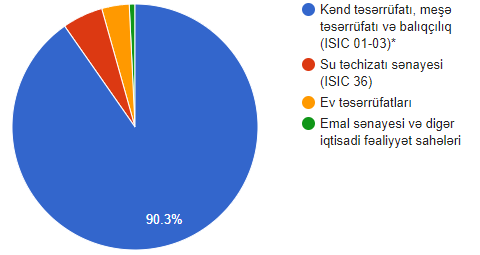
Many improvements need to be made in water efficiency, particularly in the agricultural sector and in reducing water losses during water transportation.
Features of the indicator
Description of the pointer
The total volume of fresh water withdrawn annually (surface and groundwater) - according to the International Standard for the Industrial Classification of All Economic Activities (ISIC) for all economic activities and expressed as a percentage of renewable fresh water resources - that is, the WEI km of the country.
Units
The total volume of fresh water withdrawal and the total volume for economic activities are measured in million cubic meters (million m 3 ) per year; WEI is expressed as a percentage.
Justification
Rationale for indicator selection
The indicator provides a measure of pressures on the environment in terms of abstraction of fresh water from natural sources as well as fresh water resources.
Monitoring of freshwater abstraction is of great importance for Azerbaijan in terms of preserving renewable water resources and improving the sustainability of water resources management. This indicator allows for a correct evaluation of the preservation and efficient use of Azerbaijan's natural resources.
Scientific references
- UNECE, 2011. Azerbaijan - Second Environmental Action Review, United Nations Economic Commission for Europe, Environmental Action Review Series No. 31, e-ISBN 978-92-1-117035-1, New York and Geneva.
- UNECE, 2018. Guidelines for the Implementation of Environmental Indicators, Description of C2. Withdrawal of fresh water.
- UNECE, 2018. Guidelines for the Application of Environmental Indicators, Glossary of Terms – C2. Withdrawal of fresh water.
Political context and objectives
A description of the context
National political context
The Water Code of the Republic of Azerbaijan (1997) was adopted by the Law No. 418-IQ of the Republic of Azerbaijan dated December 26, 1997. The part of the Caspian Sea (lake) belonging to Azerbaijan is part of the natural wealth of the Azerbaijani people and is used and protected as the basis of life and activity of the population and to ensure the existence of flora and fauna. The Code regulates the legal rules in the field of using and protecting water bodies in Azerbaijan.
International political context
Sustainable Development Goal 6 (SDG 6) of the UN's 2030 Agenda for Sustainable Development is to "ensure access to water and sanitation for all". One of the indicators of SDG 6, indicator 6.4.2, is called "level of water stress: water withdrawal as a proportion of available freshwater resources", which shows the importance of a sustainable water policy.
Targets
National goals
No national target has been set.
International goals
UN SDG 6, target 6.4 : By 2030, significantly increase water use efficiency across all sectors and ensure sustainable abstraction and supply of freshwater to address water scarcity, as well as significantly reduce the number of people suffering from water scarcity.
Relevant political documents
Water Code of the Republic of Azerbaijan, 1997. Adopted by the Law No. 418-IQ of the Republic of Azerbaijan dated December 26, 1997.
Sustainable Development Goals. UN (2016). Sustainable development goals, sustainable development agenda.
Methodology
Methodology for calculating the indicator
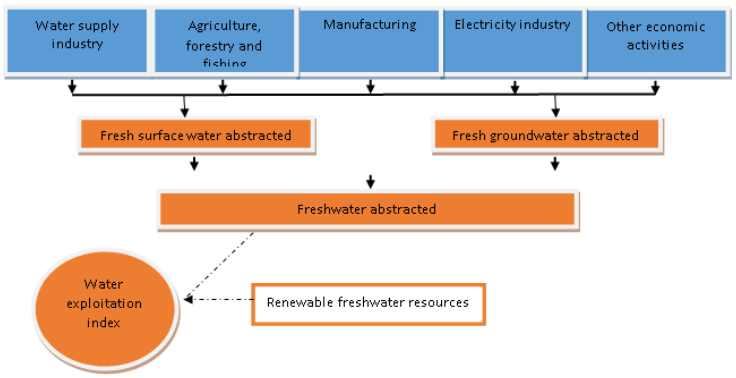
Units and equations
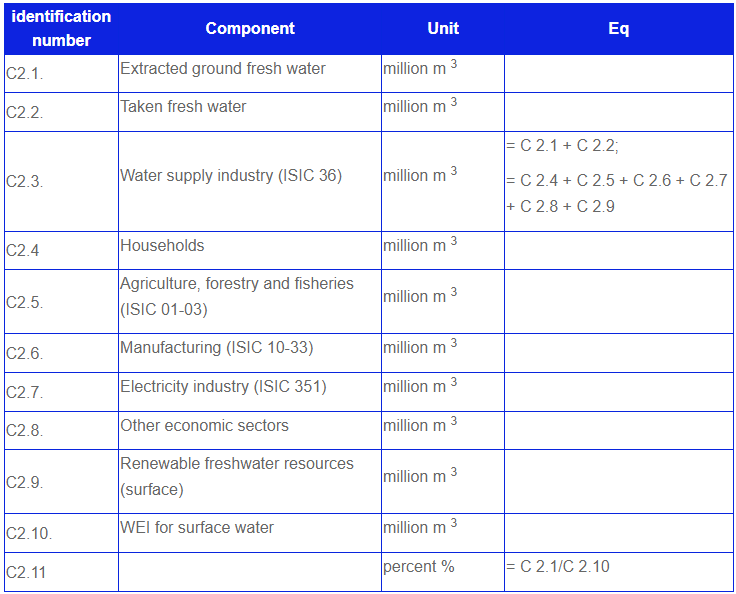
Gap filling methodology
No gap-filling methodology was implemented.
Methodological references
- EEA, 2005. Guide to the EEA core set of indicators. EEA Technical report No. 1/2005, ISBN 92-9167-757-4, Luxembourg.
- UNECE, 2018. Guidelines for the Implementation of Environmental Indicators, Data Template – C2. Withdrawal of fresh water.
- UNECE, 2018 . Guidelines for the Application of Environmental Indicators, Description of C2. Withdrawal of fresh water.
- UNECE, 2018 . Guidelines for Application of Environmental Indicators, Glossary of Terms – C2. Withdrawal of fresh water.
- UNSD and UNEP, 2013. Environmental Statistics Survey 2013. United Nations Statistics Division and United Nations Environment Programme, Environmental Statistics Survey 2013, Water Division.
Uncertainties
Uncertainties in methodology
The classification of economic activities in the data obtained from the statistical agency is inconsistent with ISIC version 4. Therefore, the data and information presented in this indicator are not fully suitable for regional assessment.
Data uncertainty
No ambiguity was detected.
Ambiguity in reasoning
No ambiguity was detected.
Information sources
- Information on water abstraction by sources and economic activities was provided by the Ministry of Ecology and Natural Resources of the Republic of Azerbaijan.
- Information on water resources was provided by the State Statistics Committee of the Republic of Azerbaijan.
Metadata
Themes: water
Indicator code: C2
Tags: water withdrawal, water consumption index, Azerbaijan
Time period covered: 2000-2019
DPSIR: pressure
Typology: descriptive indicator (Type A - what is happening to the environment and people?)
Dates
Publication date:
Last modified:
Frequency of updates: every year
Contact information and ownership
Coordinator:
Ownership: State Statistics Committee of the Republic of Azerbaijan
Related content
Short term work
No short-term jobs have been identified.
Long term work
The National Water Strategy is being developed.
